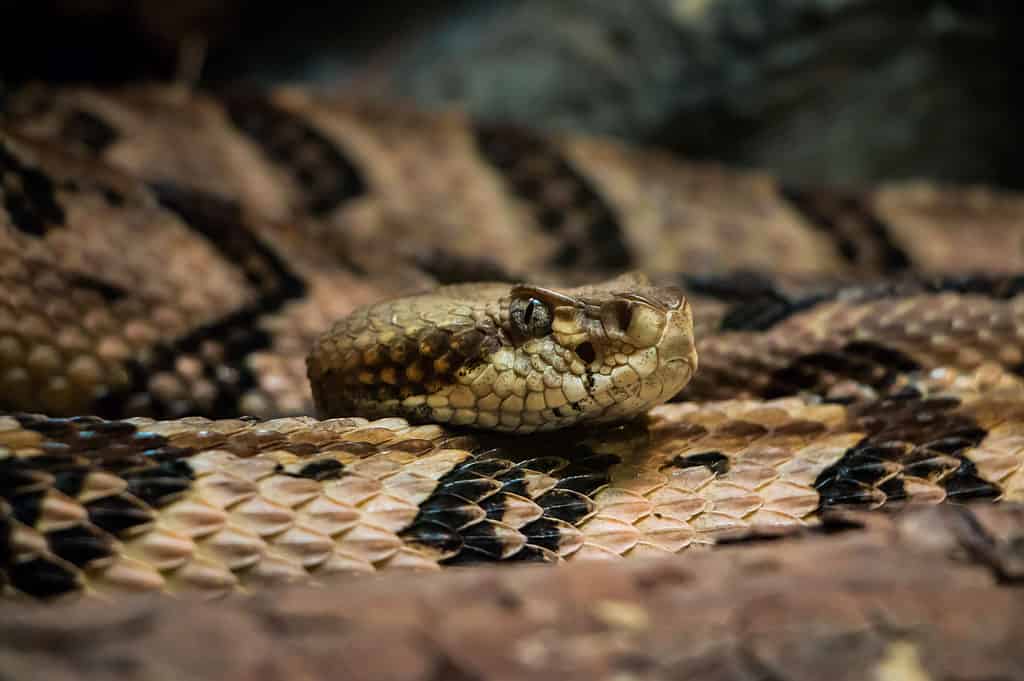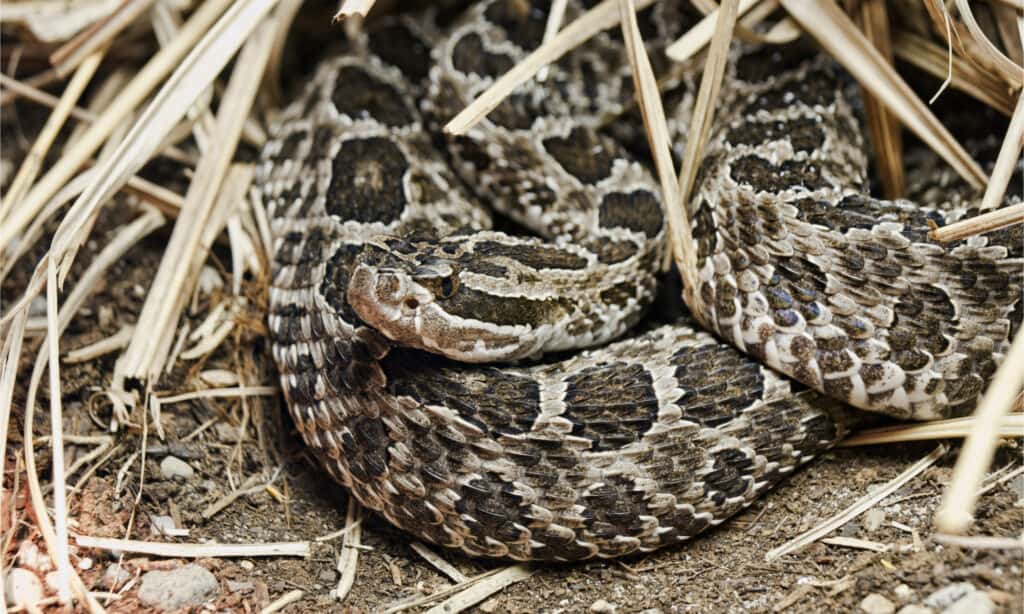Rattlesnakes are among the most feared reptiles in North America. Even if you love snakes, there’s an unmistakable menace in that rattling coming from their tails! So, it makes sense that you want to understand when they’re active so you can avoid them.
However, reptile enthusiasts who like to go herping also want to know when they’re active — for a whole different reason!
In either case, you’ll need to know a couple of things:
- Which rattlesnakes live in Ohio
- Why they’re active at certain times and not others
- Where you’re most likely to see one
Which Rattlesnake Species Live in Ohio?
Only three venomous snake species inhabit Ohio. They’re all pit vipers, but only two are rattlesnakes.
- Copperhead (Agkistrodon contortrix)
- Timber rattlesnake (Crotalus horridus)
- Eastern massasauga (Sistrurus catenatus)
Although both rattlesnake species are endangered in Ohio and the eastern massasauga is federally threatened, both are still around hunting rodents! As their name implies, there’s a rattle at the end of their tails.
Although the sound of a rattle sends a shiver down many spines, it’s not actually a threat — it’s an early warning system. Scientists believe that rattlesnakes developed in North America as a direct response to bison. It was a way for the snake to let the bison know that they were too close so they didn’t step on the snake.
Timber Rattlesnake (Crotalus horridus)

Timber rattlesnakes prefer dry, wooded hill places where they prey on a variety of small warm-blooded animals.
©Dennis Riabchenko/Shutterstock.com
Once common across Ohio, timber rattlesnakes only occur in the state’s far north and south areas. They are one of the biggest rattlesnake species in North America, behind the eastern diamondback rattlesnake.
These reclusive snakes prefer hiding in the forest along game trails, where they can snatch a quick meal as it wanders along. Timber rattlesnakes often sit in one location for days until a juicy mouse gets close enough to grab.
Timber rattlesnakes typically measure between three and five feet long but can reach six. These snakes are heavy-bodied and bulky-looking. Like many pit vipers, they have big, spade-shaped heads with dark stripes behind their eyes.
The species has two basic color phases: yellow and black.
Black phase timber rattlesnakes are melanistic. It’s a common genetic trait in the species that makes them darken to nearly black with age. Juveniles start out gray with black m or v-shaped cross bands, then become darker with each passing year.
Yellow phase timber rattlesnakes aren’t melanistic and instead develop a yellowish tint to their base color. However, some individuals don’t display either trait and keep the gray to dark-gray even as they age.
Most timber rattlesnakes have a yellowish to orange dorsal stripe interrupted by their cross band markings.
Like other pit vipers, timber rattlesnakes have big venom glands behind their eyes that attach to hinged hypodermic needles known as fangs. They can inject huge amounts of venom in a single bite, but are surprisingly reluctant to bite.
They’re very shy and if you come across one, it’s likely to freeze in place. This species often doesn’t even rattle until you get really close. These ambush predators depend on their camouflage and hope you don’t see them. As a result, they don’t usually attack unless stepped on or harassed.
Eastern Massasauga (Sistrurus catenatus)

Massaugas are rare in Ohio, but more common in the central and western areas.
©DnDavis/Shutterstock.com
This pint-sized rattlesnake is mistaken for a juvenile of another species. An adult eastern massasauga is only 24 to 30 inches long. Even their rattle is tiny! It produces a higher-pitched buzzing sound in comparison to the distinct rattling of a bigger species. Shy and reclusive just like their larger cousins, these snakes are rare in Ohio. Their range once covered most of the state, but they’re mostly found in central and western Ohio now.
Where the timber rattlesnake prefers the forest floor, the eastern massasauga is more of a marsh and wet prairie snake. They’re more likely to be found among piles of damp debris and recently flooded grasslands.
Eastern massasauga rattlesnakes are gray to brown with black or dark brown rounded dorsal blotches. Along their sides are three rows of smaller offset blotches that sometimes merge. They’re pit vipers and have heat sensing pits between their nostril and eye.
Are Rattlesnakes Active in Ohio During the Winter?
When rattlesnakes are active throughout the year depends on a few factors, but the biggest is the ambient temperature — is it warm enough to support their bodies? Snakes are cold-blooded and rely on the sun’s heat to keep their bodily functions, well, functioning.
So, while some animals are active throughout the winter, North American reptiles must find a safe place to pass the winter.
What is Brumation?
Brumation is the reptile answer to mammalian hibernation. It’s similar, except that that they’re not deeply asleep and still need to drink. An interesting thing about snakes is that they can handle lower amounts and wider fluctuations of oxygen in their environment. It gives them the luxury of choosing brumation dens with little air flow.
Each snake species has limits for the temperatures they can tolerate, making knowing when rattlesnakes will be most active a little tricky. For example, if they take a meal when they’re too cold to digest it, the meal can rot in their stomach — something they probably won’t survive.
Below about 60 degrees, most rattlesnakes start looking for their dens. But before the weather cools off too much, they eat as much as possible to build up extra fat and sugar. Snakes use the fat stores to support breeding in the spring and the sugar to survive the winter.
Rattlesnakes often share brumation dens peacefully with other species. Some timber rattlesnake dens have been used by generations of snakes.
Periodically through the winter, rattlesnakes may leave their dens on nicer days to bask and get a drink of water. Otherwise, they’ll stay tucked into dens that may hold generations of rattlesnakes — in some species grandmothers, mothers, and their offspring stay nearby during brumation. They may even associate with one another during the rest of the year.
When are Rattlesnakes Most Active In Ohio?
During the spring, rattlesnakes are often active all day long. The ambient temperature is terrific and they can bask on a rock after their first meal of the year. After all, what’s nicer than sunning yourself on a rock?
Rattlesnakes are more active when they’re traveling to and from their brumation dens — that’s when you’re more likely to spot a rattlesnake in Ohio. Once they’re out, mated, and moved on, they usually find a comfortable spot to wait for a meal. They’re relatively sedentary animals, although they can travel a couple of miles from their den.
Their need to manage their body temperature overrules their desire for a particular part of the day. Once summer arrives and we’re out at campsites for the night, so are the snakes. When it gets too hot for them to be active during the day, rattlesnakes shift to a crepuscular (morning and evening) and nocturnal pattern.
According to iNaturalist.org, rattlesnake sightings peak between June and August. However, they can be sighted year round if the weather is right.
The good news (for rattlesnakes) is that those heat-sensing pits can help them find food even on a dark moonless night. So, the time of year only matters where controlling their body temperature is concerned.
How Do You Avoid a Rattlesnake Run-in?
If you spend a lot of time bushwhacking — running around in the brush exploring — you’ll need to wear pants and leather shoes.
Otherwise, stick to the trails! Even if you do run across a rattlesnake, you’ll have a much better chance of seeing it before something bad happens.
Using a walking stick to help move things around in dense leaf litter will also give you and the rattlesnake enough warning to avoid each other. However, the best advice is to be careful. Know when and where you’re most likely to run into a snake, and take appropriate precautions.
Although rattlesnakes often freeze when they see you, they don’t want to bite you. They want to be left alone to do rattlesnake things.
The photo featured at the top of this post is © Frode Jacobsen/Shutterstock.com
Discover the "Monster" Snake 5X Bigger than an Anaconda
Every day A-Z Animals sends out some of the most incredible facts in the world from our free newsletter. Want to discover the 10 most beautiful snakes in the world, a "snake island" where you're never more than 3 feet from danger, or a "monster" snake 5X larger than an anaconda? Then sign up right now and you'll start receiving our daily newsletter absolutely free.
Thank you for reading! Have some feedback for us? Contact the AZ Animals editorial team.






